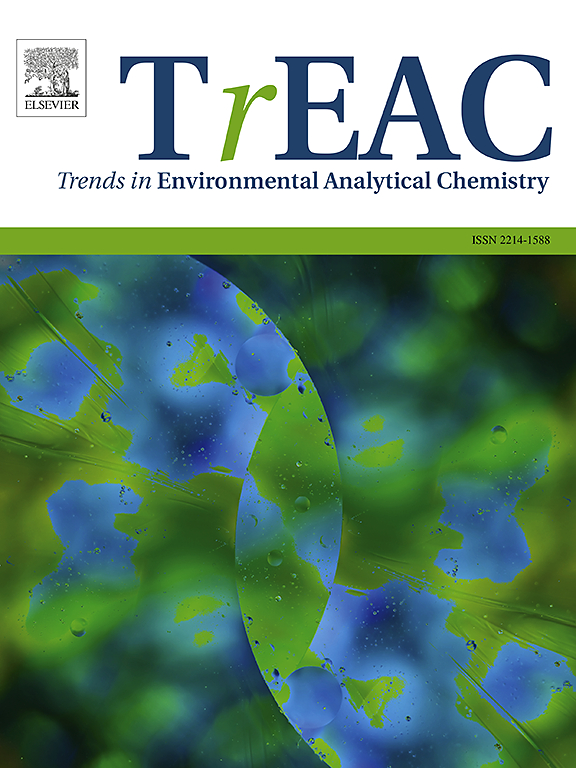非侵入性家畜样品抗生素检测无预处理便携式传感方法的进展:正面清单制度法规的评价与要求
IF 13.4
2区 化学
Q1 CHEMISTRY, ANALYTICAL
引用次数: 0
摘要
合成抗生素通过治疗多种动物相关疾病,在牲畜生产和提高饲料转化率方面发挥着重要作用。家畜抗生素的过量使用加剧了食品中的抗生素掺假,对人类造成了危害,扰乱了生态和环境系统。在这方面,建立严格的法规和正面清单制度(PLS),教育农民,制造简单、低成本、快速、无创、无预处理和便携式设备,以精确、快速和现场识别抗生素,无疑是必要的,也是早就应该做到的。这样的设备将遵守PLS指南,有效地检测最大残留限量(MRLs),并保护环境和人类免受抗生素的毒性影响。在这里,我们对PLS的全球现状,其意义以及用于检测牲畜抗生素的现场传感策略的最新研究进展进行了全面的回顾。此外,我们详细讨论了现场传感方法和分析性能,并确定所描述策略的检测极限是否符合MRL要求。此外,我们描述了未来的挑战、趋势、观点和分析方法,并提供了样品提取技术的概述。目前基于生物分子和合成受体传感器的科学技术研究大大提高了在牲畜现场识别抗生素的能力。比色检测技术由于其直接、高选择性和灵敏度,为实时监测抗生素提供了最大的潜力。这项研究强调了与便携式设备相关的新概念、见解和挑战,这些设备有可能用作检测牲畜抗生素的简单纸质传感器。本文章由计算机程序翻译,如有差异,请以英文原文为准。
Advancements in pretreatment-free portable sensing approaches for antibiotics detection in non-invasive livestock samples: Assessment and requirement of positive list system regulations
Synthetic antibiotics play an important role in livestock productivity and improve feed conversion rates by treating numerous animal-related diseases. The over-dosage of antibiotics to domestic animals has worsened antibiotic adulteration in food products, resulting in hazardous effects on humans and disturbing ecological and environmental systems. In this respect, establishing strict regulations and a positive list system (PLS), educating farmers, and fabricating simple, low-cost, rapid, non-invasive, pretreatment-free, and portable devices for precise, quick, and on-site recognition of antibiotics is undeniably essential and overdue. Such a device would adhere to the PLS guidelines, effectively detect maximum residue limits (MRLs), and protect both the environment and humans from the toxic effects of antibiotics. Here, we conduct a thorough review of the global status of PLS, its significance, and the latest advancements in research on on-site sensing strategies designed to detect antibiotics in livestock. Also, we address on-site sensing methods and analytical performances in detail and determine whether the limit of detection of described strategies meets MRL requirements. In addition, we describe future challenges, trends, perspectives, and analytical methods and provide an overview of sample extraction techniques. Current scientific and technological studies based on biomolecule and synthetic receptor-based sensors have considerably increased the ability to recognize antibiotics in livestock on-site. Colorimetric detection techniques offer the most potential for monitoring antibiotics in real time due to their straightforwardness, high selectivity, and sensitivity. This study highlights novel concepts, insights, and challenges associated with portable devices with potential use as simple paper-based sensors for detecting antibiotics in livestock.
求助全文
通过发布文献求助,成功后即可免费获取论文全文。
去求助
来源期刊

Trends in Environmental Analytical Chemistry
Chemistry-Analytical Chemistry
CiteScore
21.20
自引率
2.70%
发文量
34
审稿时长
44 days
期刊介绍:
Trends in Environmental Analytical Chemistry is an authoritative journal that focuses on the dynamic field of environmental analytical chemistry. It aims to deliver concise yet insightful overviews of the latest advancements in this field. By acquiring high-quality chemical data and effectively interpreting it, we can deepen our understanding of the environment. TrEAC is committed to keeping up with the fast-paced nature of environmental analytical chemistry by providing timely coverage of innovative analytical methods used in studying environmentally relevant substances and addressing related issues.
 求助内容:
求助内容: 应助结果提醒方式:
应助结果提醒方式:


